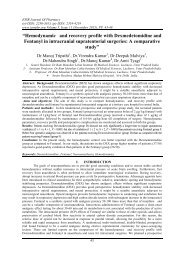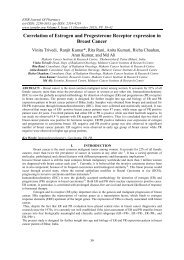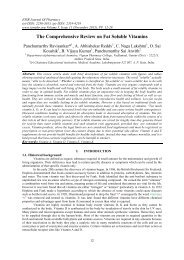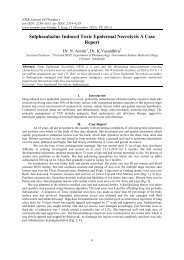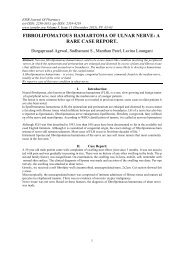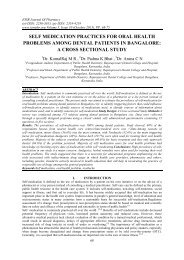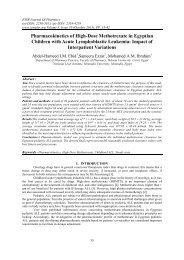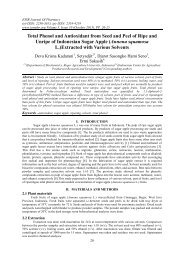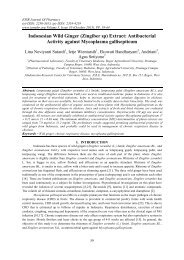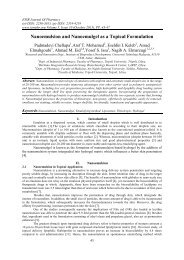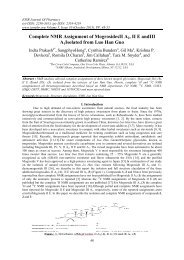Studies on combined effect of Aeromonas hydrophila and cadmium on lipid peroxidation and antioxidant status in selected tissues of Indian freshwater major carp, Catla catla: role of silver nanoparticles
You also want an ePaper? Increase the reach of your titles
YUMPU automatically turns print PDFs into web optimized ePapers that Google loves.
IOSR Journal Of Pharmacy<br />
(e)-ISSN: 2250-3013, (p)-ISSN: 2319-4219<br />
www.iosrphr.org Volume 4, Issue 10 (October 2014), PP. 01-07<br />
<str<strong>on</strong>g>Studies</str<strong>on</strong>g> <strong>on</strong> <strong>comb<strong>in</strong>ed</strong> <strong>effect</strong> <strong>of</strong> Aerom<strong>on</strong>as <strong>hydrophila</strong> <strong>and</strong><br />
<strong>cadmium</strong> <strong>on</strong> <strong>lipid</strong> peroxidati<strong>on</strong> <strong>and</strong> <strong>antioxidant</strong> <strong>status</strong> <strong>in</strong> <strong>selected</strong><br />
<strong>tissues</strong> <strong>of</strong> <strong>Indian</strong> <strong>freshwater</strong> <strong>major</strong> <strong>carp</strong>, <strong>Catla</strong> <strong>catla</strong>: <strong>role</strong> <strong>of</strong> <strong>silver</strong><br />
<strong>nanoparticles</strong><br />
T. Kiran Reddy, T.N.V.K.V. Prasad 1 , S. Janardana Reddy*<br />
Department <strong>of</strong> Fishery Science <strong>and</strong> Aquaculture,Sri Venkateswara University, Tirupati-517 502, AP, INDIA<br />
1 Department <strong>of</strong> Soil Sciences, Sri Venkateswara Agricultural College, Tirupati-517 502, AP, INDIA<br />
ABSTRACT-. The present study was aimed to evaluate the <strong>effect</strong> <strong>of</strong> dual stressors <strong>cadmium</strong> (Cd) <strong>and</strong><br />
Aerom<strong>on</strong>as <strong>hydrophila</strong> (AH) <strong>on</strong> pro-<strong>and</strong> <strong>antioxidant</strong> <strong>status</strong> <strong>in</strong> gills, kidneys <strong>and</strong> liver <strong>tissues</strong> <strong>of</strong> fishes, <strong>Catla</strong><br />
<strong>catla</strong> treated with or without <strong>silver</strong> nano-particles. Significant elevati<strong>on</strong> <strong>in</strong> the <strong>lipid</strong> peroxidati<strong>on</strong> levels with a<br />
significant decrease <strong>in</strong> the activity levels <strong>of</strong> superoxide dismutase, catalase, glutathi<strong>on</strong>e-S-transferase <strong>in</strong> were<br />
observed <strong>in</strong> gills, kidneys <strong>and</strong> liver <strong>tissues</strong> <strong>of</strong> fishes exposed to <strong>in</strong>dividual <strong>and</strong>/or <strong>in</strong> comb<strong>in</strong>ati<strong>on</strong> with Cd <strong>and</strong> AH<br />
over c<strong>on</strong>trols. However, significant elevati<strong>on</strong> <strong>in</strong> the activity levels <strong>of</strong> xanth<strong>in</strong>e oxidase was observed <strong>in</strong> the<br />
<strong>selected</strong> <strong>tissues</strong> <strong>of</strong> fishes treated with Cd, AH <strong>and</strong> Cd+AH over c<strong>on</strong>trols. On the other h<strong>and</strong>, AgNPs showed a<br />
reversal <strong>effect</strong> <strong>on</strong> Cd-, AH- <strong>and</strong> Cd+AH-<strong>in</strong>duced alterati<strong>on</strong>s <strong>in</strong> <strong>lipid</strong> peroxidati<strong>on</strong> levels <strong>and</strong> <strong>antioxidant</strong><br />
enzymes <strong>in</strong> gills, kidneys <strong>and</strong> liver <strong>tissues</strong> <strong>of</strong> fishes over their respective c<strong>on</strong>trols. No significant changes were<br />
observed <strong>in</strong> <strong>lipid</strong> peroxidati<strong>on</strong> levels <strong>and</strong> <strong>antioxidant</strong> enzymes <strong>in</strong> <strong>selected</strong> <strong>tissues</strong> <strong>of</strong> fishes exposed to AgNPs<br />
al<strong>on</strong>e as compared to untreated fishes. From the f<strong>in</strong>d<strong>in</strong>gs it is clear that AgNPs protects gills, kidneys <strong>and</strong> liver<br />
aga<strong>in</strong>st Cd <strong>and</strong> AH <strong>in</strong>duced oxidative stress. Further studies <strong>in</strong> this directi<strong>on</strong> might def<strong>in</strong>itely augment the use <strong>of</strong><br />
nano-based compounds as therapeutic c<strong>and</strong>idates <strong>in</strong> fisheries.<br />
KEY WORDS- A. <strong>hydrophila</strong>, <strong>Catla</strong> <strong>catla</strong>, <strong>lipid</strong> peroxidati<strong>on</strong>, <strong>antioxidant</strong> enzymes, <strong>silver</strong> <strong>nanoparticles</strong><br />
I. INTRODUCTION<br />
Food sector is an important area <strong>of</strong> public c<strong>on</strong>cern. Am<strong>on</strong>g food sector <strong>in</strong>dustries, aquaculture occupies<br />
a strategic positi<strong>on</strong> all over the world (1). However, waterborne diseases, <strong>in</strong>clud<strong>in</strong>g bacterial <strong>in</strong>fecti<strong>on</strong>s affect<br />
aquaculture <strong>in</strong>dustry <strong>and</strong> <strong>in</strong> particular fisheries thereby causes ec<strong>on</strong>omic loses to aqua-farmers (2). Am<strong>on</strong>g a<br />
range <strong>of</strong> bacterial diseases, Aerom<strong>on</strong>as <strong>hydrophila</strong> (AH) mediated diseases severely affect fisheries (3).<br />
Indigenous fishes such as <strong>Catla</strong> <strong>catla</strong> is <strong>on</strong>e <strong>of</strong> the commercially <strong>and</strong> highly cultivable species across India (4).<br />
Previously, it has been <strong>in</strong>dicated that AH negatively affect spleen, liver, kidneys <strong>and</strong> gills <strong>and</strong> eventually<br />
<strong>in</strong>terferes with immune system <strong>and</strong> physiological events <strong>in</strong> fishes <strong>in</strong>clud<strong>in</strong>g C. <strong>catla</strong> (5-8). Thus, it is obvious<br />
that A. <strong>hydrophila</strong> adversely affects all vital organs <strong>and</strong> subsequently leads to death <strong>of</strong> fishes. To overcome AH<br />
mediated adverse <strong>effect</strong>s, currently antimicrobial agents such as terramyc<strong>in</strong> <strong>and</strong> Remet-30 are widely used.<br />
However, due to frequent use <strong>of</strong> these antibiotics <strong>in</strong> fisheries, resistance developed by bacteria aga<strong>in</strong>st these<br />
antibiotics is a <strong>major</strong> limit<strong>in</strong>g factor to prevent <strong>and</strong> c<strong>on</strong>trol AH mediated <strong>in</strong>fecti<strong>on</strong>s. Thus, it is important to<br />
develop novel alternative strategies to c<strong>on</strong>trol Aerom<strong>on</strong>as <strong>in</strong>fecti<strong>on</strong>s <strong>in</strong> fishes. On the other h<strong>and</strong>, toxic impact <strong>of</strong><br />
heavy metals <strong>in</strong>clud<strong>in</strong>g <strong>cadmium</strong> (Cd) <strong>in</strong> fisheries is <strong>in</strong>creas<strong>in</strong>g at an alarm<strong>in</strong>g rate (9). Earlier it has been<br />
<strong>in</strong>dicated that <strong>cadmium</strong> has ability to bioaccumulate <strong>in</strong> fish organs <strong>and</strong> exerts negative <strong>effect</strong>s <strong>on</strong> hematological<br />
<strong>and</strong> physiological aspects <strong>of</strong> fishes (10). Dur<strong>in</strong>g recent past, exposure <strong>of</strong> aquatic organisms to dual stressors<br />
such as physical <strong>and</strong>/or biological factors is unavoidable. However, studies related to the exposure <strong>of</strong> fishes to<br />
dual stressors such as bacteria <strong>and</strong> heavy metals (eg: Cd) are not well def<strong>in</strong>ed.Recently, the <strong>role</strong> <strong>of</strong><br />
nanotechnology <strong>in</strong> pharmaceutical area <strong>and</strong> <strong>in</strong> particular aga<strong>in</strong>st bacterial <strong>in</strong>fecti<strong>on</strong>s is well appreciated (11).<br />
This aspect attracted the attenti<strong>on</strong> <strong>of</strong> aqua based farmers all over the world <strong>and</strong> as a result the applicati<strong>on</strong> <strong>of</strong><br />
nano based particles <strong>in</strong> the field <strong>of</strong> aquaculture is ga<strong>in</strong><strong>in</strong>g importance day-by-day. Silver nano-particles (AgNPs)<br />
are classical nano-based compounds that are widely used as antibacterial agent aga<strong>in</strong>st broad spectrum <strong>of</strong><br />
bacteria (12). Earlier, it has also been reported that AgNPs particles show potential antimicrobial efficacy<br />
aga<strong>in</strong>st AH bacteria (13). Previously, we dem<strong>on</strong>strated that <strong>silver</strong> <strong>nanoparticles</strong> play a pivotal <strong>role</strong> <strong>in</strong> energy<br />
metabolism <strong>in</strong> fishes <strong>in</strong>fected with AH (8). Thus, it seems apparent that AgNPs at least <strong>in</strong> part cross-talk with<br />
energy metabolism <strong>in</strong> fishes dur<strong>in</strong>g stress c<strong>on</strong>diti<strong>on</strong>s. Therefore, <strong>in</strong> view <strong>of</strong> the above facts, the present study<br />
was further aimed to evaluate whether AgNPs has any <strong>role</strong> aga<strong>in</strong>st <strong>comb<strong>in</strong>ed</strong> <strong>effect</strong> <strong>of</strong> <strong>cadmium</strong> <strong>and</strong> AH<br />
<strong>in</strong>duced alterati<strong>on</strong>s <strong>in</strong> pro-<strong>and</strong> <strong>antioxidant</strong> <strong>status</strong> <strong>in</strong> fishes.<br />
1
<str<strong>on</strong>g>Studies</str<strong>on</strong>g> <strong>on</strong> <strong>comb<strong>in</strong>ed</strong> <strong>effect</strong> <strong>of</strong> Aerom<strong>on</strong>as…<br />
II. MATERIALS AND METHODS<br />
2.1. Collecti<strong>on</strong> <strong>and</strong> ma<strong>in</strong>tenance <strong>of</strong> fishes<br />
<strong>Catla</strong> <strong>catla</strong> (10.0 ± 0.52 cm <strong>in</strong> length <strong>and</strong> 11.0 ± 1.2 g <strong>in</strong> weight) were <strong>selected</strong> as experimental fishes<br />
for the present study. <strong>Catla</strong> <strong>catla</strong> (10.0 ± 0.52 cm <strong>in</strong> length <strong>and</strong> 11.0 ± 1.2 g <strong>in</strong> weight) were purchased from<br />
A.P. Government Central Fish Farm, Kalyani dam, Chittoor Distrtict, AP, INDIA. Fishes <strong>of</strong> male sex were<br />
ma<strong>in</strong>ta<strong>in</strong>ed <strong>in</strong> cement aquaria (each 1,000 liters capacity), where they received un-chlor<strong>in</strong>ated c<strong>on</strong>t<strong>in</strong>uous gentle<br />
flow <strong>of</strong> water from a deeply sunk bore well with<strong>in</strong> University campus. Fishes were ma<strong>in</strong>ta<strong>in</strong>ed under c<strong>on</strong>trolled<br />
laboratory c<strong>on</strong>diti<strong>on</strong>s. All the fishes were acclimated for at least two weeks <strong>and</strong> fed ad libitum fish diet <strong>in</strong> a<br />
laboratory c<strong>on</strong>diti<strong>on</strong>s at the ambient, unc<strong>on</strong>trolled temperature <strong>of</strong> 28 ± 2 ⁰ C under the 12h:12h light:dark<br />
c<strong>on</strong>diti<strong>on</strong>s. The fish were starved 24 h prior to the start <strong>of</strong> the experiments <strong>in</strong> order to avoid metabolic variati<strong>on</strong>s<br />
due to diet, if any.<br />
2.2. Bacterial stra<strong>in</strong><br />
A. <strong>hydrophila</strong> was obta<strong>in</strong>ed from Microbial Type Culture Collecti<strong>on</strong> <strong>and</strong> Gene Bank (MTCC) Institute<br />
<strong>of</strong> Microbial Technology, Sector 39-A, Ch<strong>and</strong>igarh, India. After obta<strong>in</strong><strong>in</strong>g bacteria, it was cultured <strong>in</strong> trypt<strong>on</strong>e<br />
soya broth (Himedia) for 24 h at 37 ⁰ C. After <strong>in</strong>cubati<strong>on</strong> period, the culture was centrifuged at 800g for 15 m<strong>in</strong> at<br />
4 ⁰ C. The packed cells were washed with phosphate buffered sal<strong>in</strong>e (PBS; pH 7.2) twice <strong>and</strong> then the required<br />
dose was prepared <strong>in</strong> PBS. The bacterial suspensi<strong>on</strong> was prepared to 1x10 9 Col<strong>on</strong>y Forg Units as determ<strong>in</strong>ed<br />
us<strong>in</strong>g a Neubauer haemocytometer.<br />
2.3. Ag nano-particles<br />
In the present study, citrate coated Ag <strong>nanoparticles</strong> were prepared us<strong>in</strong>g chemical routes with an<br />
average size <strong>of</strong> 30nm. The measured zeta potentials <strong>of</strong> prepared Ag <strong>nanoparticles</strong> were formed to be -42mv.<br />
AgNPs stocks were prepared by suspend<strong>in</strong>g 100 mg <strong>of</strong> citrate coated AgNPs <strong>in</strong> 1 litre millipore water <strong>and</strong><br />
mixed well by s<strong>on</strong>icat<strong>in</strong>g for at least 30 m<strong>in</strong>utes. After, s<strong>on</strong>icati<strong>on</strong> the diluti<strong>on</strong>s were prepared as required.<br />
2.4. Experimental design<br />
The fishes were r<strong>and</strong>omly allocated <strong>in</strong>to follow<strong>in</strong>g groups:<br />
C<strong>on</strong>trol group<br />
Group 1<br />
Fishes ma<strong>in</strong>ta<strong>in</strong>ed <strong>on</strong> normal water (n=10)<br />
Experimental Groups<br />
Group 2 : Cadmium exposed fishes (n=10)<br />
Group 3 : Aerom<strong>on</strong>as <strong>hydrophila</strong> <strong>in</strong>fected fishes (n=10).<br />
Group 4 : Comb<strong>in</strong>ed treatment <strong>of</strong> <strong>cadmium</strong> <strong>in</strong>toxicati<strong>on</strong> <strong>and</strong> A. <strong>hydrophila</strong> <strong>in</strong>fected<br />
fishes (n=10)<br />
Group 5 : Silver <strong>nanoparticles</strong> (AgNPs) exposed fishes (n=10)<br />
Group 6 : Cadmium + AgNPs treated fishes (n=10)<br />
Group 7 : A. <strong>hydrophila</strong> <strong>in</strong>fecti<strong>on</strong> + AgNPs treated fishes (n=10)<br />
Group 8 : <strong>cadmium</strong> <strong>in</strong>toxicati<strong>on</strong> + A. <strong>hydrophila</strong> <strong>in</strong>fecti<strong>on</strong> + AgNPs treated fishes<br />
(n=10)<br />
Fishes <strong>in</strong> groups 2, 4, 6 <strong>and</strong> 8 received daily sub lethal c<strong>on</strong>centrati<strong>on</strong> <strong>of</strong> <strong>cadmium</strong> chloride (based <strong>on</strong><br />
probit analysis for 96hrs LC 50 the c<strong>on</strong>centrati<strong>on</strong> <strong>of</strong> CdCl 2 to <strong>Catla</strong> <strong>catla</strong> was determ<strong>in</strong>ed as 21.53mg/l; Therefore<br />
for the present study, 1/5 th LC 50 4.036 mg/l was <strong>selected</strong> as test dose). The heavy metal c<strong>on</strong>ta<strong>in</strong><strong>in</strong>g water<br />
medium was changed at every 24h <strong>in</strong> order to ma<strong>in</strong>ta<strong>in</strong> a c<strong>on</strong>stant sub lethal c<strong>on</strong>centrati<strong>on</strong> <strong>of</strong> heavy metal. In the<br />
present study, 1/10th c<strong>on</strong>centrati<strong>on</strong> <strong>of</strong> 100 µg <strong>of</strong> AgNPs/L was <strong>selected</strong> as test dose. The dose selecti<strong>on</strong> was<br />
based <strong>on</strong> earlier reports (8, 14). The quantity <strong>of</strong> <strong>silver</strong> <strong>in</strong> the <strong>selected</strong> c<strong>on</strong>centrati<strong>on</strong>s was determ<strong>in</strong>ed by atomic<br />
absorpti<strong>on</strong> spectroscopy available <strong>in</strong> Department <strong>of</strong> Soil Sciences, S.V. Agricultural College, Tirupati, AP,<br />
INDIA. Fishes <strong>in</strong> groups 5 to 8 were exposed to AgNPs at <strong>selected</strong> c<strong>on</strong>centrati<strong>on</strong>s. The AgNPs c<strong>on</strong>ta<strong>in</strong><strong>in</strong>g<br />
medium was changed at every 24 h. Fishes <strong>in</strong> groups 3, 4, 7 <strong>and</strong> 8 were <strong>in</strong>tramuscularly <strong>in</strong>jected just below the<br />
dorsal f<strong>in</strong> with A. <strong>hydrophila</strong> (1x10 9 CFU/50µl <strong>of</strong> 0.85% NaCl). The dose selecti<strong>on</strong> was based <strong>on</strong> histological<br />
alterati<strong>on</strong>s <strong>of</strong> <strong>selected</strong> <strong>tissues</strong> <strong>and</strong> also based <strong>on</strong> previous studies (7, 8). Dis<strong>in</strong>fecti<strong>on</strong> was performed before<br />
<strong>in</strong>jecti<strong>on</strong>s us<strong>in</strong>g 70% ethanol <strong>and</strong> sterile <strong>and</strong> disposable <strong>in</strong>sul<strong>in</strong> syr<strong>in</strong>ges were used for <strong>in</strong>jecti<strong>on</strong> purposes. In the<br />
present study, respective c<strong>on</strong>trols were also ma<strong>in</strong>ta<strong>in</strong>ed al<strong>on</strong>g with experimental groups.<br />
The experimental period was about fourteen days. After completi<strong>on</strong> <strong>of</strong> experimental period, all the<br />
fishes <strong>in</strong> the groups were euthanized <strong>and</strong> <strong>selected</strong> <strong>tissues</strong> were immediately isolated, washed, blotted <strong>and</strong><br />
weighed us<strong>in</strong>g Shimadzu electr<strong>on</strong>ic balance nearest to milligram <strong>and</strong> stored at -80⁰C until further use.<br />
2
<str<strong>on</strong>g>Studies</str<strong>on</strong>g> <strong>on</strong> <strong>comb<strong>in</strong>ed</strong> <strong>effect</strong> <strong>of</strong> Aerom<strong>on</strong>as…<br />
2.5. Antioxidant enzymes<br />
For the present study the activity levels <strong>of</strong> <strong>antioxidant</strong> enzymes such as superoxide dismutase, catalase,<br />
xanth<strong>in</strong>e oxidase <strong>and</strong> glutathi<strong>on</strong>e-S-transferase were assayed <strong>in</strong> gills, liver <strong>and</strong> kidney <strong>tissues</strong> <strong>of</strong> c<strong>on</strong>trol <strong>and</strong><br />
experimental fishes.<br />
The organs were homogenized <strong>in</strong> 4 volumes <strong>of</strong> homogeniz<strong>in</strong>g buffer (50mM Tris-HCl mixed with<br />
1.15% KCl <strong>and</strong> pH adjusted to 7.4), us<strong>in</strong>g a Tefl<strong>on</strong> homogenizer. The result<strong>in</strong>g homogenate was centrifuged at<br />
4,000g for 15 m<strong>in</strong>. to remove cell debris. The supernanant was collected <strong>and</strong> aga<strong>in</strong> centrifuged at 16,000g for 45<br />
m<strong>in</strong>utes at 4°C to obta<strong>in</strong> the supernatant fracti<strong>on</strong>. The <strong>antioxidant</strong> enzymes <strong>and</strong> <strong>lipid</strong> peroxidati<strong>on</strong> levels were<br />
assayed us<strong>in</strong>g the supernatant fracti<strong>on</strong>.<br />
Glutathi<strong>on</strong>e S-transferase (GST) activity was determ<strong>in</strong>ed by the method <strong>of</strong> Habig et al. (15) us<strong>in</strong>g 1<br />
chloro 2, 4 d<strong>in</strong>itrobenzene as substrate <strong>and</strong> the activity levels <strong>of</strong> GST is expressed as nmoles <strong>of</strong> GSH-CDNB<br />
c<strong>on</strong>jugate formed/m<strong>in</strong>/mg prote<strong>in</strong>. Superoxide dismutase (SOD) activity was determ<strong>in</strong>ed by measur<strong>in</strong>g the<br />
<strong>in</strong>hibiti<strong>on</strong> <strong>of</strong> auto-oxidati<strong>on</strong> <strong>of</strong> ep<strong>in</strong>ephr<strong>in</strong>e as described by Misra <strong>and</strong> Fridovich et al. (16) <strong>and</strong> the units <strong>of</strong> SOD<br />
were expressed as units/mg prote<strong>in</strong>. One unit <strong>of</strong> SOD activity is the amount <strong>of</strong> SOD required to cause 50%<br />
<strong>in</strong>hibiti<strong>on</strong> <strong>of</strong> adrenal<strong>in</strong>e autooxidati<strong>on</strong>. The activity <strong>of</strong> catalase (CAT; 17) was determ<strong>in</strong>ed us<strong>in</strong>g hydrogen<br />
peroxide as substrate <strong>and</strong> the activity was expressed as µmoles <strong>of</strong> hydrogen peroxide decomposed/mg<br />
prote<strong>in</strong>/m<strong>in</strong>. Xanth<strong>in</strong>e oxidase (XOD) was determ<strong>in</strong>ed by the method described by Srikanthan <strong>and</strong><br />
Krishnamurthy (18) us<strong>in</strong>g xanth<strong>in</strong>e as substrate. The units <strong>of</strong> XOD were expressed as µ moles <strong>of</strong> formazan<br />
formed / mg prote<strong>in</strong> / hour. Lipid peroxidati<strong>on</strong> (LPx) was measured for the c<strong>on</strong>tent <strong>of</strong> mal<strong>on</strong>dialdehyde (MDA).<br />
LPx was measured us<strong>in</strong>g the thiobarbituric acid (TBA) assay by the method <strong>of</strong> Hiroshi et al. (19). The units <strong>of</strong><br />
LPx were expressed as nmoles <strong>of</strong> MDA formed/hour/g tissue. All the assays were run <strong>in</strong> triplicates.<br />
2.6. Estimati<strong>on</strong> <strong>of</strong> prote<strong>in</strong>s<br />
The prote<strong>in</strong> c<strong>on</strong>tent <strong>in</strong> the enzyme source was estimated by the Lowry et al. (20) us<strong>in</strong>g Fol<strong>in</strong> phenol<br />
reagent us<strong>in</strong>g bov<strong>in</strong>e serum album<strong>in</strong> as st<strong>and</strong>ard.<br />
2.7. Statistics<br />
The data were presented as mean ± S.D. Analysis <strong>of</strong> variance (<strong>on</strong>e way ANOVA) followed by<br />
Dunnet’s test was used to analyze the data statistically. The differences were c<strong>on</strong>sidered to be significant at p <<br />
0.01. All statistical tests were performed us<strong>in</strong>g Statistical Package for Social Sciences (SPSS Inc., Chertsey,<br />
UK).<br />
III. RESULTS<br />
3.1. General toxicity<br />
No mortality was observed <strong>in</strong> any <strong>of</strong> the c<strong>on</strong>trols <strong>and</strong> experimental groups. N<strong>on</strong>e <strong>of</strong> the fishes were<br />
excluded.<br />
3.2. Effect <strong>of</strong> <strong>comb<strong>in</strong>ed</strong> <strong>effect</strong> <strong>of</strong> <strong>cadmium</strong>+A. <strong>hydrophila</strong> <strong>on</strong> <strong>lipid</strong> peroxidati<strong>on</strong> levels <strong>in</strong> <strong>selected</strong><br />
<strong>tissues</strong> <strong>of</strong> fishes treated with or without AgNPs<br />
No significant changes <strong>in</strong> the LPx levels were observed <strong>in</strong> gills, liver <strong>and</strong> kidneys <strong>of</strong> fishes ma<strong>in</strong>ta<strong>in</strong>ed<br />
<strong>in</strong> water c<strong>on</strong>ta<strong>in</strong><strong>in</strong>g 1/10 th c<strong>on</strong>centrati<strong>on</strong>s <strong>of</strong> 100µg/l <strong>of</strong> AgNPs as compared to c<strong>on</strong>trol fishes (Table 1).<br />
Cadmium treated <strong>and</strong> A. <strong>hydrophila</strong> <strong>in</strong>fected fishes showed a significant <strong>in</strong>crease <strong>in</strong> the LPx levels <strong>of</strong> <strong>selected</strong><br />
<strong>tissues</strong> over their respective c<strong>on</strong>trols. Furthermore, <strong>comb<strong>in</strong>ed</strong> <strong>effect</strong> <strong>of</strong> <strong>cadmium</strong>+A. <strong>hydrophila</strong> showed<br />
accelerated <strong>in</strong>crease <strong>in</strong> the LPx levels <strong>of</strong> <strong>selected</strong> <strong>tissues</strong> <strong>in</strong> fishes. On the other h<strong>and</strong>, AgNPs showed a<br />
significant decrease <strong>in</strong> the LPx levels <strong>of</strong> <strong>selected</strong> <strong>tissues</strong> <strong>in</strong> <strong>in</strong>dividual <strong>and</strong>/or comb<strong>in</strong>ati<strong>on</strong> <strong>of</strong> <strong>cadmium</strong><br />
<strong>in</strong>toxicated <strong>and</strong> A. <strong>hydrophila</strong> <strong>in</strong>fected fishes (Table 1).<br />
3.3. Effect <strong>of</strong> <strong>comb<strong>in</strong>ed</strong> <strong>effect</strong> <strong>of</strong> <strong>cadmium</strong>+A. <strong>hydrophila</strong> <strong>on</strong> the activity levels <strong>of</strong> <strong>antioxidant</strong> enzymes<br />
<strong>in</strong> <strong>selected</strong> <strong>tissues</strong> <strong>of</strong> fishes treated with or without AgNPs<br />
Significant (p
4<br />
<str<strong>on</strong>g>Studies</str<strong>on</strong>g> <strong>on</strong> <strong>comb<strong>in</strong>ed</strong> <strong>effect</strong> <strong>of</strong> Aerom<strong>on</strong>as…<br />
IV. DISCUSSION<br />
The <strong>role</strong> <strong>of</strong> nanotechnology <strong>in</strong> aquaculture <strong>and</strong> <strong>in</strong> particular fisheries is well acknowledged (21).<br />
However, c<strong>on</strong>cerns are grow<strong>in</strong>g day-by-day towards the usage <strong>of</strong> nanoproducts <strong>in</strong> aquaculture (21) as they have<br />
been associated with toxic <strong>effect</strong>s. Thus, underst<strong>and</strong><strong>in</strong>g the mechanisms <strong>of</strong> <strong>nanoparticles</strong> <strong>in</strong> the physiology <strong>of</strong><br />
fishes provide valuable <strong>in</strong>formati<strong>on</strong> <strong>in</strong> the management <strong>of</strong> <strong>nanoparticles</strong> <strong>in</strong> fisheries. So far, studies related to the<br />
AgNPs have been very variable <strong>and</strong> depend <strong>on</strong> the type <strong>and</strong> nature <strong>of</strong> AgNPs, the c<strong>on</strong>centrati<strong>on</strong> tested, size,<br />
mode <strong>of</strong> exposure <strong>and</strong> the biological test species. For example, <strong>nanoparticles</strong> with various metal comb<strong>in</strong>ati<strong>on</strong>s<br />
<strong>in</strong>clud<strong>in</strong>g AgNPs <strong>and</strong> silic<strong>on</strong> dioxide NPs negatively affect hatch<strong>in</strong>g <strong>of</strong> zebra fish embryos (22) <strong>and</strong> leads to<br />
alterati<strong>on</strong>s <strong>in</strong> the <strong>antioxidant</strong> enzymes (23). On the other h<strong>and</strong>, no significant changes were observed <strong>in</strong> the LPx<br />
levels <strong>in</strong> gills, liver <strong>and</strong> kidneys <strong>of</strong> ra<strong>in</strong>bow trout, Oncorhynhus myksis treated with AgNPs (14). Previously, we<br />
dem<strong>on</strong>strated that citrate-coated AgNPs plays an important <strong>role</strong> <strong>in</strong> energy metabolism as evidenced by a balance<br />
between aerobic to anaerobic marker enzymes succ<strong>in</strong>ate dehydrogenase <strong>and</strong> lactate dehydrogenase, respectively<br />
<strong>in</strong> AH <strong>in</strong>fected fishes (8). Further, titanium dioxide <strong>nanoparticles</strong> protect silkworm, Bombyx mori aga<strong>in</strong>st<br />
phoxim <strong>in</strong>duced oxidative stress <strong>and</strong> neurotoxicity (24, 25). Thus, it seems obvious that resp<strong>on</strong>se <strong>of</strong> biological<br />
systems towards different comb<strong>in</strong>ati<strong>on</strong>s <strong>of</strong> NPs differ at the perspective <strong>of</strong> toxicological aspects.<br />
In the present study, it is clearly evident that AgNPs showed reversal <strong>effect</strong>s aga<strong>in</strong>st Cd <strong>in</strong>toxicati<strong>on</strong><strong>and</strong><br />
AH <strong>in</strong>fecti<strong>on</strong>-<strong>in</strong>duced changes <strong>in</strong> the activity levels <strong>of</strong> pro-<strong>and</strong> <strong>antioxidant</strong> <strong>status</strong> <strong>in</strong> the gills, liver <strong>and</strong><br />
kidneys <strong>of</strong> fishes, <strong>Catla</strong> <strong>catla</strong>. It is well known that a balance between generati<strong>on</strong> <strong>of</strong> free radicals <strong>and</strong> <strong>in</strong>tr<strong>in</strong>sic<br />
<strong>antioxidant</strong> system is crucial for a range <strong>of</strong> physiological functi<strong>on</strong>s. In the present study, Cd <strong>in</strong>toxicati<strong>on</strong> <strong>and</strong> AH<br />
<strong>in</strong>fecti<strong>on</strong> al<strong>on</strong>e or <strong>in</strong> comb<strong>in</strong>ati<strong>on</strong> showed reducti<strong>on</strong> <strong>in</strong> the activity levels <strong>of</strong> <strong>antioxidant</strong> enzymes such as SOD,<br />
GST <strong>and</strong> CAT <strong>in</strong> gills, liver <strong>and</strong> kidneys <strong>of</strong> fishes. On the other h<strong>and</strong>, LPx levels were significantly enhanced <strong>in</strong><br />
these <strong>tissues</strong> <strong>of</strong> fishes exposed to Cd al<strong>on</strong>e or <strong>in</strong> comb<strong>in</strong>ati<strong>on</strong> with AH <strong>in</strong>fecti<strong>on</strong>. The results are <strong>in</strong> c<strong>on</strong>s<strong>on</strong>ance<br />
with previous reports (26-28). It is well known that Cd severely affects structural <strong>and</strong> functi<strong>on</strong>al <strong>in</strong>tegrity <strong>of</strong><br />
<strong>tissues</strong> through oxidative stress. Previously, it has been shown that Cd has ability to compete with essential<br />
metals <strong>in</strong> prote<strong>in</strong>-b<strong>in</strong>d<strong>in</strong>g sites lead<strong>in</strong>g to trigger<strong>in</strong>g release <strong>of</strong> ferrous <strong>and</strong> cuprous i<strong>on</strong>s thereby elevat<strong>in</strong>g the<br />
levels <strong>of</strong> reactive oxygen species (ROS) (29). In additi<strong>on</strong>, it has been reported that Cd negatively targets<br />
mitoch<strong>on</strong>drial electr<strong>on</strong> transport, <strong>and</strong> as a result shifts electr<strong>on</strong> directly to oxygen which eventually leads to<br />
generati<strong>on</strong> <strong>of</strong> (ROS) <strong>and</strong> causes LPx mediated damage <strong>in</strong> liver, kidney <strong>and</strong> gills (30). On the other h<strong>and</strong>, AH<br />
<strong>in</strong>fecti<strong>on</strong> also <strong>in</strong>duced oxidative stress <strong>in</strong> <strong>selected</strong> <strong>tissues</strong> <strong>of</strong> fishes by elevat<strong>in</strong>g the levels <strong>of</strong> LPx. The results are<br />
<strong>in</strong> agreement with earlier studies (31). This might be due to deteriorati<strong>on</strong> <strong>of</strong> structural <strong>in</strong>tegrity <strong>of</strong> <strong>tissues</strong> (8, 31).<br />
SOD <strong>and</strong> CAT acts as cyclic enzymes to counterattack superoxides <strong>and</strong> hydroperoxides, respectively<br />
(32). In the present study, the reducti<strong>on</strong> <strong>in</strong> the activity levels <strong>of</strong> SOD <strong>in</strong>dicates improper removal <strong>of</strong> superoxides<br />
<strong>and</strong> CAT <strong>in</strong>dicates loss <strong>of</strong> its activity to mitigate hydrogen peroxide <strong>in</strong> gills, kidneys <strong>and</strong> liver <strong>of</strong> Cd <strong>in</strong>toxicated<br />
<strong>and</strong> AH <strong>in</strong>fected fishes. Further, glutathi<strong>on</strong>e related enzymes such as GST plays an important <strong>role</strong> <strong>in</strong> phase II<br />
detoxificati<strong>on</strong> mechanisms. Its activity is crucial to mitigate the <strong>lipid</strong> peroxidati<strong>on</strong> products accumulated <strong>in</strong><br />
<strong>tissues</strong> (33). Thus, the reducti<strong>on</strong> <strong>in</strong> the activity levels <strong>of</strong> GST <strong>in</strong>dicates a failure <strong>of</strong> removal <strong>of</strong> <strong>lipid</strong> peroxidati<strong>on</strong><br />
products <strong>in</strong> <strong>tissues</strong>. Interest<strong>in</strong>gly, the activity levels <strong>of</strong> XOD an enzyme that plays an important <strong>role</strong> <strong>in</strong><br />
detoxificati<strong>on</strong> mechanisms was significantly <strong>in</strong>creased <strong>in</strong> <strong>selected</strong> <strong>tissues</strong> <strong>of</strong> Cd, AH <strong>and</strong> Cd+AH treated fishes.<br />
Previously, it has been shown that XOD levels alter <strong>in</strong> kidney tissue <strong>of</strong> fishes dur<strong>in</strong>g Cd-<strong>in</strong>duced stress (28). It is<br />
well known that SOD <strong>and</strong> CAT act as cyclic enzymes to mitigate superoxides <strong>and</strong> hydroperoxides (32).<br />
However, failure <strong>of</strong> these enzymes subsequently leads to accumulati<strong>on</strong> <strong>of</strong> superoxides <strong>and</strong> hydroperoxides<br />
which <strong>in</strong> turn negatively target structural <strong>in</strong>tegrity <strong>of</strong> <strong>tissues</strong>. Thus, the failure <strong>of</strong> SOD <strong>and</strong> enhanced activity <strong>of</strong><br />
XOD, a detoxificati<strong>on</strong> enzyme that leads to superoxides might also resp<strong>on</strong>sible for the accumulati<strong>on</strong> <strong>of</strong><br />
superoxides which eventually targets catalase <strong>and</strong> its expressi<strong>on</strong>. Furthermore, all these sequential cascade <strong>of</strong><br />
events leads to accumulati<strong>on</strong> <strong>of</strong> hydrogen peroxide <strong>in</strong> the <strong>tissues</strong> which <strong>in</strong> turn targets SOD <strong>and</strong> its expressi<strong>on</strong>.<br />
One <strong>of</strong> the important f<strong>in</strong>d<strong>in</strong>gs <strong>of</strong> the present study <strong>in</strong>dicates that AgNPs showed reversal <strong>effect</strong>s <strong>on</strong> Cd,<br />
AH <strong>and</strong> Cd+AH <strong>in</strong>duced alterati<strong>on</strong>s <strong>in</strong> pro-<strong>and</strong> <strong>antioxidant</strong> <strong>status</strong> <strong>in</strong> gills, kidneys <strong>and</strong> liver <strong>of</strong> fishes, <strong>Catla</strong><br />
<strong>catla</strong>. No studies so for reported the ability <strong>of</strong> AgNPs to protect fishes aga<strong>in</strong>st pro-<strong>and</strong> anti-oxidant changes<br />
<strong>in</strong>duced by dual stressors such as Cd <strong>and</strong> AH. Perhaps, the present study was the first to dem<strong>on</strong>strate the<br />
protective <strong>effect</strong> <strong>of</strong> AgNPs aga<strong>in</strong>st Cd-, AH- <strong>and</strong> Cd+AH-<strong>in</strong>duced altered <strong>status</strong> <strong>in</strong> the activity levels <strong>of</strong><br />
<strong>antioxidant</strong> enzymes such as SOD, CAT, XOD <strong>and</strong> GST <strong>in</strong> fishes, <strong>Catla</strong> <strong>catla</strong>. Although, the exact<br />
mechanism(s) <strong>of</strong> acti<strong>on</strong> <strong>of</strong> AgNPs <strong>in</strong>duced <strong>in</strong>hibiti<strong>on</strong> <strong>of</strong> LPx levels <strong>in</strong> <strong>selected</strong> <strong>tissues</strong> <strong>of</strong> Cd, AH, Cd+AH<br />
treated fishes are not well def<strong>in</strong>ed, it has been suggested that ma<strong>in</strong>tenance <strong>of</strong> structural <strong>in</strong>tegrity <strong>of</strong> <strong>tissues</strong> might<br />
be <strong>on</strong>e <strong>of</strong> the plausible reas<strong>on</strong>s which could susta<strong>in</strong> a balance between generati<strong>on</strong> <strong>of</strong> ROS <strong>and</strong> <strong>antioxidant</strong><br />
enzymes. It is unequivocal that improper management <strong>of</strong> mitoch<strong>on</strong>drial electr<strong>on</strong> transport <strong>and</strong> respiratory cha<strong>in</strong><br />
events are at least <strong>in</strong> part result <strong>in</strong> generati<strong>on</strong> <strong>of</strong> ROS. Previous studies from our laboratory <strong>in</strong>dicate that AgNPs<br />
showed enhanced activity levels <strong>of</strong> mitoch<strong>on</strong>drial marker enzyme succ<strong>in</strong>ate dehydrogenase <strong>in</strong> AH <strong>in</strong>fected gills,
5<br />
<str<strong>on</strong>g>Studies</str<strong>on</strong>g> <strong>on</strong> <strong>comb<strong>in</strong>ed</strong> <strong>effect</strong> <strong>of</strong> Aerom<strong>on</strong>as…<br />
kidney <strong>and</strong> liver <strong>of</strong> fishes <strong>in</strong>dicat<strong>in</strong>g the normal functi<strong>on</strong>al activity <strong>of</strong> mitoch<strong>on</strong>dria. Recently, studies <strong>of</strong> Xie et<br />
al. <strong>and</strong> Su et al. (24, 25) reported that Titanium dioxide <strong>nanoparticles</strong> (TiO 2 NPs) protected bra<strong>in</strong> tissue from<br />
oxidative stress <strong>in</strong>duced by organophosphorus pesticide, phoxim <strong>in</strong> silk worm, Bombyx mori. The same authors<br />
<strong>in</strong>dicated that TiO 2 NPs suppressed oxidative stress <strong>in</strong> <strong>selected</strong> <strong>tissues</strong> <strong>of</strong> <strong>in</strong>sects might be due to regulati<strong>on</strong> <strong>of</strong><br />
expressi<strong>on</strong> <strong>of</strong> genes such as caspases which are believed to be important <strong>in</strong> oxidative stress <strong>and</strong> mitoch<strong>on</strong>dria<br />
<strong>and</strong> respiratory cha<strong>in</strong> (24, 25). Recently, studies <strong>of</strong> Oliveira et al. (34), <strong>in</strong>dicated that AgNPs with organic<br />
additives such as (1) 5-Am<strong>in</strong>oisoqu<strong>in</strong>ol<strong>in</strong>e, (2) 7-am<strong>in</strong>o-4-methylcoumar<strong>in</strong>, <strong>and</strong> (3) 2-Am<strong>in</strong>oanthraceneas did<br />
not elicit same resp<strong>on</strong>ses <strong>in</strong> pro- (mal<strong>on</strong>dialdehyde levels) <strong>and</strong> <strong>antioxidant</strong> enzymes such as CAT <strong>and</strong> GST <strong>in</strong><br />
<strong>in</strong>test<strong>in</strong>e <strong>and</strong> liver <strong>tissues</strong> <strong>of</strong> gold fish, Carassius auratus. The same authors reported that AgNPs with organic<br />
additive 1 <strong>and</strong> 2 showed no changes <strong>in</strong> LPx levels <strong>and</strong> the activity levels <strong>of</strong> <strong>antioxidant</strong> enzymes such as GST<br />
<strong>and</strong> CAT <strong>in</strong> <strong>in</strong>test<strong>in</strong>e <strong>and</strong> liver <strong>of</strong> gold fishes whereas AgNPs with organic additive 3 showed oxidative stress <strong>in</strong><br />
gold fishes, suggest<strong>in</strong>g the importance <strong>of</strong> surround<strong>in</strong>g envir<strong>on</strong>ment <strong>of</strong> AgNPs. Moreover, it has also been shown<br />
that AgNPs with organic additive 1 exhibited cytotoxicity <strong>of</strong> mammalian cells, HepG2 cells as compared to<br />
AgNPs with organic additive 3 which exhibited lower cell toxicity <strong>of</strong> HepG2 cells (34). It is noteworthy to<br />
menti<strong>on</strong> that TiO 2 NPs enhanced the <strong>antioxidant</strong> system aga<strong>in</strong>st phoxim-<strong>in</strong>duced oxidative stress <strong>in</strong> Bombyx mori<br />
(25). Further, it has been suggested that TiO 2 NPs have ability to act at the level <strong>of</strong> expressi<strong>on</strong> <strong>of</strong> resistancerelated<br />
genes <strong>and</strong> their prote<strong>in</strong>s, <strong>in</strong>clud<strong>in</strong>g those encod<strong>in</strong>g SOD, CAT, GPX, <strong>and</strong> GST, which <strong>in</strong> turn mitigate<br />
ROS <strong>in</strong> B. mori larvae under BmNPV <strong>in</strong>fecti<strong>on</strong> (35). In the present study, AgNPs mediated protecti<strong>on</strong> seems to<br />
be <strong>in</strong>direct. We hypothesize that AgNPs through unknown mechanisms ma<strong>in</strong>ta<strong>in</strong> structural <strong>in</strong>tegrity <strong>of</strong> <strong>tissues</strong><br />
which <strong>in</strong> turn susta<strong>in</strong>s <strong>in</strong>tr<strong>in</strong>sic <strong>antioxidant</strong> <strong>status</strong> <strong>in</strong> Cd exposed fishes; <strong>in</strong> additi<strong>on</strong>, AgNPs through<br />
antimicrobial properties mitigate AH col<strong>on</strong>izati<strong>on</strong> which <strong>in</strong> turn <strong>in</strong>hibits AH-<strong>in</strong>duced negative <strong>effect</strong>s <strong>on</strong> pro<strong>and</strong><br />
<strong>antioxidant</strong> <strong>status</strong> <strong>in</strong> <strong>selected</strong> <strong>tissues</strong> <strong>of</strong> fishes. Further, studies aim<strong>in</strong>g at molecular aspects related to pro<strong>and</strong><br />
<strong>antioxidant</strong> system such as expressi<strong>on</strong> <strong>of</strong> caspases are <strong>in</strong> progress <strong>in</strong> our laboratory to explore AgNPs<br />
<strong>in</strong>duced protecti<strong>on</strong> aga<strong>in</strong>st Cd, AH, Cd+AH-<strong>in</strong>duced oxidative stress.<br />
V. CONCLUSION<br />
The present study addresses the therapeutic utility <strong>of</strong> AgNPs aga<strong>in</strong>st dual stress factors (metal toxicity:<br />
Cd <strong>and</strong> bacterial <strong>in</strong>fecti<strong>on</strong>s: Aerom<strong>on</strong>as <strong>hydrophila</strong> <strong>in</strong>fecti<strong>on</strong>s) <strong>in</strong> vivo. This provides the first evidence that<br />
Cd+AH at least <strong>in</strong> part targets pro-<strong>and</strong> anti-oxidant <strong>status</strong> <strong>and</strong> it could seriously compromise fish health. Our<br />
results also <strong>in</strong>dicated that AgNPs protects fishes aga<strong>in</strong>st dual stress (Cd+AH) -<strong>in</strong>duced oxidative stress.<br />
Although, the recovery was observed <strong>in</strong> pro- <strong>and</strong> anti-oxidant <strong>status</strong> <strong>in</strong> AgNPs supplemented experimental<br />
groups (Cd, AH <strong>and</strong> Cd+AH), the <strong>effect</strong> was partial. Thus, usage <strong>of</strong> AgNPs as therapeutic c<strong>and</strong>idates <strong>in</strong><br />
aquaculture needs further research. On the other h<strong>and</strong>, the present study provides a platform <strong>and</strong> paves a way for<br />
young researchers to meet the gaps <strong>and</strong> challenges <strong>in</strong> this field. Thus, further research <strong>in</strong> fish model(s)<br />
developed will strengthen <strong>and</strong> exp<strong>and</strong> the knowledge <strong>on</strong> AgNPs <strong>and</strong> its cross-talk with fish physiology dur<strong>in</strong>g<br />
dual stress c<strong>on</strong>diti<strong>on</strong>s. F<strong>in</strong>ally, studies <strong>in</strong> this directi<strong>on</strong> could help to shape the applicati<strong>on</strong> <strong>of</strong> nano-based<br />
c<strong>and</strong>idates <strong>in</strong> aquaculture.<br />
VI. ACKNOWLEDGEMENTS<br />
The authors thank Head, Department <strong>of</strong> Aquaculture, S. V. University, Tirupati-517 502 <strong>and</strong> Head,<br />
Department <strong>of</strong> Soil Sciences, S.V. Agricultural College Tirupati-517 502, AP, India for provid<strong>in</strong>g laboratory<br />
facilities <strong>and</strong> <strong>silver</strong> <strong>nanoparticles</strong>, respectively.<br />
REFERENCES<br />
[1]. K. Anjani, P.K. Joshi <strong>and</strong> S.B. Pratap, Fisheries Sector <strong>in</strong> India: An Overview <strong>of</strong> Performance, Policies <strong>and</strong> Programmes, <strong>in</strong> K.<br />
Anjani, K.K. Pradeep <strong>and</strong> P.K. Joshi (Eds.), A Pr<strong>of</strong>ile <strong>of</strong> People, Technologies <strong>and</strong> Policies <strong>in</strong> Fisheries Sector <strong>in</strong> India, (2003)<br />
1-16.<br />
[2]. B. Mohanty, S. Mohanty, J. Sahoo <strong>and</strong> A. Sharma, Climate Change: Impacts <strong>on</strong> Fisheries <strong>and</strong> Aquaculture, <strong>in</strong> S. Simard (Ed.),<br />
Climate Change <strong>and</strong> Variability, (Europe: Sciyo, Intech, 2010) 1-486.<br />
[3]. M. J. A. Sarkar <strong>and</strong> M. M. Rashid, Pathogenicity <strong>of</strong> the bacterial isolate Aerom<strong>on</strong>as <strong>hydrophila</strong> to catfishes, <strong>carp</strong>s <strong>and</strong> perch,<br />
Journal <strong>of</strong> Bangladesh Agricultural University 10(1), 2012, 157-161.<br />
[4]. S. Ayyappan, <strong>and</strong> J.K. Jena, Grow-out producti<strong>on</strong> <strong>of</strong> <strong>carp</strong>s <strong>in</strong> India, Journal <strong>of</strong> Applied Aquaculture 13(3/4), 2003, 251-282.<br />
[5]. J.L. Torres, M. Sharif <strong>and</strong> A.T. Law, Identificati<strong>on</strong> <strong>and</strong> virulence screen<strong>in</strong>g <strong>of</strong> Aerom<strong>on</strong>as spp. isolated from healthy <strong>and</strong><br />
epizootic ulcerative syndrome (EUS) <strong>in</strong>fected fish, <strong>in</strong> R. Hirano, <strong>and</strong> I. Hanyu (Eds.), Proceed<strong>in</strong>gs <strong>of</strong> the Sec<strong>on</strong>d Asian Fisheries<br />
Forum, (Asian Fisheries Society, Manila, Philipp<strong>in</strong>e, 1996) pp. 663-668.<br />
[6]. H.A.C.C. Perera, <strong>and</strong> A. Pathiratne, Enhancement <strong>of</strong> immune resp<strong>on</strong>ses <strong>in</strong> <strong>Indian</strong> <strong>carp</strong>, <strong>Catla</strong> <strong>catla</strong>, follow<strong>in</strong>g adistrati<strong>on</strong> <strong>of</strong><br />
levamisole by immersi<strong>on</strong>, <strong>in</strong> M.G. B<strong>on</strong>dad-Reantaso, C.V. Mohan, M. Crumlish, <strong>and</strong> R.P. Subas<strong>in</strong>ghe, (Eds.), Diseases <strong>in</strong> Asian<br />
Aquaculture VI. Fish Health Secti<strong>on</strong>, (Asian Fisheries Society, Manila, Philipp<strong>in</strong>es, 2008) pp 505.<br />
[7]. B. Kaleeswaran, S. Ilavenil, S. Ravikumar, Changes <strong>in</strong> biochemical, histological <strong>and</strong> specific immune parameters <strong>in</strong> <strong>Catla</strong> <strong>catla</strong><br />
(Ham.) by Cynod<strong>on</strong> dactyl<strong>on</strong> (L.), Journal <strong>of</strong> K<strong>in</strong>g Saud University – Science 24, 2012, 139-152<br />
[8]. T. Kiran Reddy, S. Janardana Reddy <strong>and</strong> T.N.V.K.V. Prasad. Effect <strong>of</strong> <strong>silver</strong> <strong>nanoparticles</strong> <strong>on</strong> energy metabolism <strong>in</strong> <strong>selected</strong><br />
<strong>tissues</strong> <strong>of</strong> Aerom<strong>on</strong>as <strong>hydrophila</strong> <strong>in</strong>fected <strong>in</strong>dian <strong>major</strong> <strong>carp</strong>, <strong>Catla</strong> <strong>catla</strong>. IOSRPHR Journal 3, 2013, 49-55.<br />
[9]. L. Jarup. Hazards <strong>of</strong> heavy metal c<strong>on</strong>tam<strong>in</strong>ati<strong>on</strong>. British Medical Bullet<strong>in</strong> 68, 2003, 167-182.
<str<strong>on</strong>g>Studies</str<strong>on</strong>g> <strong>on</strong> <strong>comb<strong>in</strong>ed</strong> <strong>effect</strong> <strong>of</strong> Aerom<strong>on</strong>as…<br />
[10]. M.A. Peraja, F. Ayala-Fierro, D, Barber, R. Casarez, L.T. Rael. Effects <strong>of</strong> micro nutrients <strong>on</strong> metal toxicity. Envir<strong>on</strong>. Health.<br />
Perspect. 106 (1), 1998, 203–216.<br />
[11]. T. V<strong>and</strong>evelde, H. Renner, G. Schlamp, Silver, <strong>silver</strong> compounds, <strong>and</strong> <strong>silver</strong> alloys. Ullmann's Encylopedia <strong>of</strong> Industrial<br />
Chemistry. chapter 10. (New York, NY, USA: John Wiley & S<strong>on</strong>s, 2009)<br />
[12]. J.S. Kim, E. Kuk, K.N. Yu, J.H. Kim, S.J. Park, H.I.Lee, S.H. Kim, S.J. Park, Y.H. Park, C.Y. Hwang, Y.K. Kim, Y.S. Lee, D.H.<br />
Je<strong>on</strong>g, M.H. Cho, Antimicrobial <strong>effect</strong>s <strong>of</strong> <strong>silver</strong> nanopaticles. Nanomedic<strong>in</strong>e: Nanotechnology Biology <strong>and</strong> Medic<strong>in</strong>e. 3, 2007,<br />
95-101.<br />
[13]. M. Soltani, M. Ghodratnema, H. Ahari, H.A. Ebrahimzadeh Mousavi, M. Atee, F. Dastmalchi, J. Rahmanya, The <strong>in</strong>hibitory<br />
<strong>effect</strong> <strong>of</strong> <strong>silver</strong> <strong>nanoparticles</strong> <strong>on</strong> the bacterial fish pathogens Streptococcus <strong>in</strong>iae Lactococcus garvieae Yers<strong>in</strong>ia ruckeri<br />
Aerom<strong>on</strong>as <strong>hydrophila</strong>, Internati<strong>on</strong>al Journal <strong>of</strong> Veter<strong>in</strong>ary Research 3,2009, 137-142.<br />
[14]. T.M. Scown, E.M. Santos, B.D. Johnst<strong>on</strong>, B. Gaiser, M. Baalousha S. Mitov, J.R. Lead, V. St<strong>on</strong>e, T.F. Fern<strong>and</strong>es, M. Jeps<strong>on</strong> et<br />
al., Effects <strong>of</strong> aqueous exposure to <strong>silver</strong> <strong>nanoparticles</strong> <strong>of</strong> different sizes <strong>in</strong> ra<strong>in</strong>bow trout. Toxicological Sciences 115, 2010,<br />
521–534.<br />
[15]. W.H. Habig, M.J. Dabit, W.B. Jacoby. Glutathi<strong>on</strong>e S-transferases: the first enzymatic step <strong>in</strong> mercapturic acid formati<strong>on</strong>. J. Biol.<br />
Chem. 249, 1974, 7130–7139.<br />
[16]. H.P. Misra, I, Fridovich. The <strong>role</strong> <strong>of</strong> Superoxide ani<strong>on</strong> <strong>in</strong> the autooxidati<strong>on</strong> <strong>of</strong> ep<strong>in</strong>ephr<strong>in</strong>e <strong>and</strong> a simple assay for superoxide<br />
dismutase J K. Biol chem. 247, 1972, 3170-3175.<br />
[17]. H, Aebi. Catalase Methods Enzymol. 105, 1984, 125-126.<br />
[18]. T.N. Srikantan, C.R. Krishnamurthy. 1955. Tetrazolium test for dehydrogenases. J. Sci. Ind. Res. 14, 1955, 206–207.<br />
[19]. O. Hiroshi, N. Ohisi <strong>and</strong> K. Yagi, Assay for <strong>lipid</strong> peroxides <strong>in</strong> animal <strong>tissues</strong> by TBA reacti<strong>on</strong>. Analytical Biochemistry 95,<br />
1979,351-358.<br />
[20]. H. Lowry, N.I. Rosebrough, A.L. Far <strong>and</strong> R.J. R<strong>and</strong>all, 1951. Prote<strong>in</strong> measurement with fol<strong>in</strong> phenol reagent, Journal <strong>of</strong><br />
Biological Chemistry 193, 1951, 265–275.<br />
[21]. R.D. H<strong>and</strong>y. FSBI Brief<strong>in</strong>g paper: Nanotechnology <strong>in</strong> fisheries <strong>and</strong> aquaculture. Fisheries Society <strong>of</strong> the British Isles, 2012, 1-29.<br />
[22]. K. Park, G. Tuttle, F. S<strong>in</strong>che, S. L. Harper. Stability <strong>of</strong> citrate-capped <strong>silver</strong> <strong>nanoparticles</strong> <strong>in</strong> exposure media <strong>and</strong> their <strong>effect</strong>s <strong>on</strong><br />
the development <strong>of</strong> embry<strong>on</strong>ic zebrafish (Danio rerio). Arch Pharm Res. 36(1), 2013, 125–133.<br />
[23]. R. Ramesh, P. Kavitha, N. Kanip<strong>and</strong>ian, S. Arun, R. Thirumurugan, P. Subramanian. Alterati<strong>on</strong> <strong>of</strong> <strong>antioxidant</strong> enzymes <strong>and</strong><br />
impairment <strong>of</strong> DNA <strong>in</strong> the SiO2 <strong>nanoparticles</strong> exposed zebra fish (Danio rerio). Envir<strong>on</strong> M<strong>on</strong>it Assess 185, 2013, 5873–5881.<br />
[24]. Y. Xie, B. Wang, F. Li, L. Ma, M. Ni, W. Shen, F. H<strong>on</strong>g, B. Li. Molecular Mechanisms <strong>of</strong> Reduced Nerve Toxicity by titanium<br />
dioxide <strong>nanoparticles</strong> <strong>in</strong> the phoxim-exposed Bra<strong>in</strong> <strong>of</strong> Bombyx mori. Plos One. 9(6), 2014, e101062.<br />
doi:10.1371/journal.p<strong>on</strong>e.0101062<br />
[25]. Su JJ, Li B, Cheng S, Zhu Z, Sang XZ, et al. Phoxim-<strong>in</strong>duced damages <strong>of</strong> Bombyx mori larval midgut <strong>and</strong> titanium dioxide<br />
<strong>nanoparticles</strong> protective <strong>role</strong> under phoxim-<strong>in</strong>duced toxicity. Envir<strong>on</strong>mental toxicology. 2013, DOI:10.1002/ tox.21866.<br />
[26]. E, Brucka-Jastrzębska. The <strong>effect</strong> <strong>of</strong> aquatic <strong>cadmium</strong> <strong>and</strong> lead polluti<strong>on</strong> <strong>on</strong> <strong>lipid</strong> peroxidati<strong>on</strong> <strong>and</strong> superoxide dismutase activity<br />
<strong>in</strong> <strong>freshwater</strong> fish. Polish J. <strong>of</strong> Envir<strong>on</strong>. Stud.19, 2010, 1139-1150<br />
[27]. A. Dabas, N. S. Nagpure, R. Kumar, B. Kushwaha, P. Kumar, W. S. Lakra. Assessment <strong>of</strong> tissue-specific <strong>effect</strong> <strong>of</strong> <strong>cadmium</strong> <strong>on</strong><br />
<strong>antioxidant</strong> defense system <strong>and</strong> <strong>lipid</strong> peroxidati<strong>on</strong> <strong>in</strong> <strong>freshwater</strong> murrel, Channa punctatus. Fish Physiol Biochem 38, 2012, 469–<br />
482.<br />
[28]. P. Siraj Basha <strong>and</strong> A. Usha Rani. Cadmium-<strong>in</strong>duced <strong>antioxidant</strong> defense mechanism <strong>in</strong> <strong>freshwater</strong> teleost Oreochromis<br />
mossambicus (Tilapia). Ecotoxicology <strong>and</strong> Envir<strong>on</strong>mental Safety 56, 2003, 218–221.<br />
[29]. A.M. Pruski, D.R. Dix<strong>on</strong>. Effects <strong>of</strong> <strong>cadmium</strong> <strong>on</strong> nuclear <strong>in</strong>tegrity <strong>and</strong> DNA repair efficiency <strong>in</strong> the gill cells <strong>of</strong> Mytilus edulis L.<br />
Aquat. Toxicol. 57, 2002, 127.<br />
[30]. S.J. Stohs, D. Hagchi, E. Hassoun, M. Bagshi. Oxidative mechanisms <strong>in</strong> the toxicity <strong>of</strong> chromium <strong>and</strong> <strong>cadmium</strong> i<strong>on</strong>s. J Envir<strong>on</strong><br />
Pathol Toxicol Oncol 19, 2000, 201–213.<br />
[31]. H. Tkachenko, N. Kurhaluk, A. Andriichuk, E. Gasiuk, S. Beschasniu. Oxidative stress biomarkers <strong>in</strong> liver <strong>of</strong> sea trout (salmo<br />
trutta m. trutta l.) affected by ulcerative dermal necrosis syndrome. Turkish Journal <strong>of</strong> Fisheries <strong>and</strong> Aquatic Sciences 14, 2014,<br />
391-402.<br />
[32]. I. Fridovich. Biological <strong>effect</strong>s <strong>of</strong> the superoxide radical. Arch Biochem Biophys 247, 1986, 1-11.<br />
[33]. P. Morrissey, P.J. O'Brien. Selenium-<strong>in</strong>dependent glutathi<strong>on</strong>e peroxidase activity <strong>in</strong> rabbit liver. Can J. Biochem. 58, 1980,<br />
1012–1017.<br />
[34]. E. Oliveira, H.M. Santos, J. Garcia-Pardo, M. D<strong>in</strong>iz, J. Lorenzo, B. Rodríguez-G<strong>on</strong>zález, J. L. Capelo, C. Lodeiro. Synthesis <strong>of</strong><br />
functi<strong>on</strong>alized fluorescent <strong>silver</strong> <strong>nanoparticles</strong> <strong>and</strong> their toxicological <strong>effect</strong> <strong>in</strong> aquatic envir<strong>on</strong>ments (Goldfish) <strong>and</strong> HEPG2 cells.<br />
Fr<strong>on</strong>t Chem. 2013; 1: 29. doi: 10.3389/fchem.2013.00029<br />
[35]. B. Li, Y. Xie, Z. Cheng, J. Cheng, R.P. Hu, S.X. Gui et al. BmNPV resistance <strong>of</strong> silkworm larvae result<strong>in</strong>g from the <strong>in</strong>gesti<strong>on</strong> <strong>of</strong><br />
TiO 2 <strong>nanoparticles</strong>. Biol Trace Elem Res 150, 2012, 221–228.<br />
6
<str<strong>on</strong>g>Studies</str<strong>on</strong>g> <strong>on</strong> <strong>comb<strong>in</strong>ed</strong> <strong>effect</strong> <strong>of</strong> Aerom<strong>on</strong>as…<br />
Table 1:<br />
Effect <strong>of</strong> <strong>silver</strong> <strong>nanoparticles</strong> (AgNPs) <strong>on</strong> <strong>lipid</strong> peroxidati<strong>on</strong> <strong>and</strong> the activity <strong>of</strong> <strong>selected</strong><br />
<strong>antioxidant</strong> enzymes <strong>in</strong> <strong>selected</strong> <strong>tissues</strong> <strong>of</strong> fishes treated with <strong>in</strong>dividual or <strong>in</strong> comb<strong>in</strong>ati<strong>on</strong> <strong>of</strong><br />
<strong>cadmium</strong> (Cd) <strong>and</strong> Aerom<strong>on</strong>as <strong>hydrophila</strong> (AH)<br />
For evaluati<strong>on</strong> <strong>of</strong> ‘p’, for Cd-exposed, AH <strong>in</strong>fected, Cd+AH treated <strong>and</strong> AgNPs, untreated fishes served as<br />
c<strong>on</strong>trols; for Cd+AgNPs, AH+AgNPs <strong>and</strong> Cd+AH+AgNPs treated fishes, Cd-exposed, AH <strong>in</strong>fected <strong>and</strong> Cd+AH<br />
treated fishes served as c<strong>on</strong>trols, respectively.<br />
*significant at p




